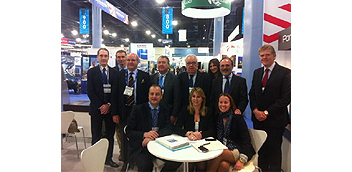

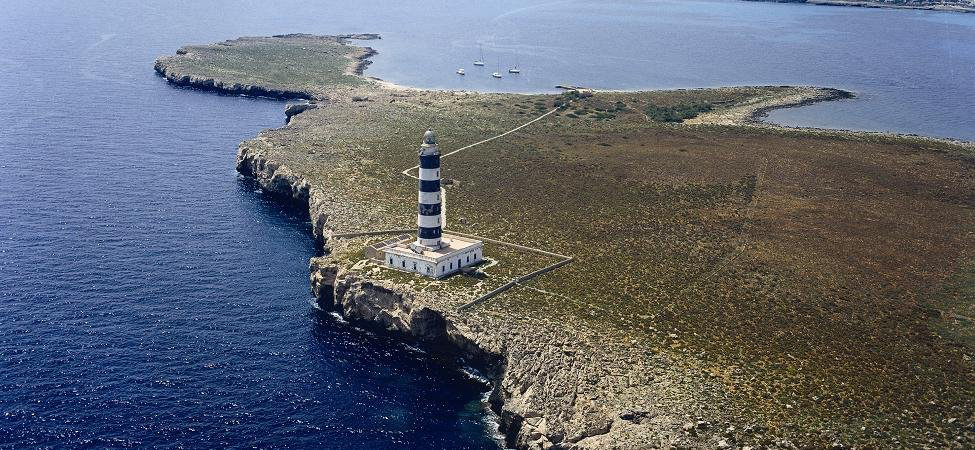
El IEO considera que el vertido al mar del material dragado en el puerto de Maó no afectará el LIC de la Isla del Aire
12/03/2013La Autoridad Portuaria de Baleares (APB) ha recibido del Instituto Español de Oceanografía (IEO) un escrito en relación al dragado del puerto de Maó, en el que da por bueno el nuevo estudio de corrientes que se ha realizado en el marco del Plan de Vigilancia Ambiental y que considera que el LIC próximo a la Isla del Aire no resultará afectado por el vertido. “Lo que se verá apoyado -añade el IEO- por la condición impuesta por la Capitanía Marítima de no realizar el vertido con un viento de componente Este mayor de 5 nudos”.En el documento, recibido la semana pasada, el IEO aprueba las aclaraciones hechas tanto por la APB como por la empresa CBBA a su primer informe de marzo de 2012, en el que realizaba varias consultas en torno al dragado. En concreto destaca “especialmente en lo que respecta a la carecterización del punto de vertido”, dado que se ha realizado una campaña oceanográfica que ha servido para completar la información ya existente.En el escrito, el IEO manifiesta que “nos parecen razonables las explicaciones que se dan cuando se analizan los valores de referencia de las RGMD (Recomendaciones para la Gestión del Material de Dragado) del CEMEX y, en todo caso, se comprende que actualmente son las recomendaciones más universales dentro del sistema portuario español”. En este sentido, el IEO matiza que los comentarios efectuados en el informe de marzo de 2012 se correponderían con la mejora y actualización de dichas RGMD, “algo en lo que se está trabajando”, confirma.El organismo dedicado a la investigación en ciencias del mar considera “fundamental el hecho de que tanto la Dirección General de Medio Rural y Marino de la CAIB como la Cofradía de pescadores de Maó estén de acuerdo con el proyecto”. También destaca que el dragado no coincida con el período de puesta del raor.Finalmente, el IEO hace “hincapié en la necesidad de un cumplimiento escrupuloso” del Plan de Vigilancia Ambiental del proyecto del dragado del puerto de Maó.
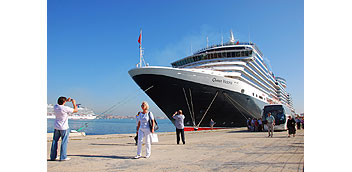
The Port Authority attends the Miami cruise fair to showcase the Balearic Islands as an established destination
10/03/2013The Port Authority of the Balearic Islands (APB) is heading the Balearic expedition to Cruise Shipping Miami, the leading international cruise shipping trade show held in the North American city from 11th to 14th March. The Balearic Island group is one of the 24 state-owned port delegations visiting the event under the umbrella of the State-owned Ports Body to present what Spanish ports have to offer to the world cruise market. The APB and the shipping agents Miguel Puigserver, Transcoma, Lantimar and Baleares Consignatarios will also be joined by the Balearic Islands Government, represented by the Balearic Islands Tourism Agency (ATB), and the Directorate-General of Ports and Airports, the Palma 365 Foundation and the city councils of Ibiza, Mahon and Alcudia. The APB has a 35m2 stand in Miami within the State-owned Ports Body exhibition area, which is second only in size to the Port of Barcelona stand. According to the APB Chairman, José Mª Urrutia, “at this show, the Balearic Islands is a mature destination which has a lot more to offer than its direct competitors and always captivates visitors with its Mediterranean personality. The APB offers a meeting point and working space for all those taking part to promote their destinations”. Currently, according to data provided by the State-owned Ports Body, APB ports come in fifth on the European cruise destination ranking and twelfth in the world. At the cruise event, the APB will be presenting the new extension of the Port of Palma’s Poniente quays which can cater for cruise ships over 300 metres long, and the new Botafoc quays at the Port of Ibiza which will further cruise market development in the Pityusic Islands. It will also be showcasing the improved depths at the Port of Mahon which aim to attract medium length cruise vessels to Minorca the modern infrastructures at the Port of Alcudia as a new, highly attractive destination for exclusive luxury cruises and the spectacular nature areas in Formentera for vessels interested in visiting La Savina. The Balearic Islands’ ports expect to welcome over 1.3 million cruise passengers on around 670 calls in 2013.
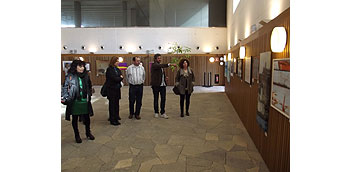
The Balearic Islands’ ports and lighthouses on display at the Ibiza Congress Center
06/03/2013The month of March sees the completion of the exhibitions held to showcase the entries in the 3rd APB Painting and Photography Competition at the Ibiza Congress Center in Santa Eulària des Riu. On this occasion, the exhibition has travelled around the islands of Majorca, Minorca and Ibiza for the first time, given the large number of participants. The 240 works entered into the competition show the interest that this type of initiative organised by the APB has generated amongst the artistic community and amateur painters and photographers. The exhibition which runs from today until 21st March showcases the twelve award-winning paintings and photographs as well as around 40 other works entered into the competition on the island of Ibiza. The Culture Councillor, Ana Costa, who attended the exhibition’s opening ceremony alongside the APB’s Head of Communication, Raimond Jaume, and the Regional Culture Minister, Josefa Costa, commented that the cooperation project had been promoted to mark the hundredth anniversary of the sinking of the Mallorca steam boat, and had taken into account the maritime theme of the competition organised by the APB. Costa also highlighted “the added value of the lighthouses that protect vessels from the dangers of the coast. Let us not forget that if the Llosa de Santa Eulària had been marked, the (Mallorca) accident would probably never have occurred”. The APB exhibited all the works entered into the 3rd Painting and Photography Competition on the Port Authority of the Balearic Islands’ ports and lighthouses during the Christmas period at the Ses Voltes Cultural Centre in Palma. In turn, the works submitted in Minorca were shown in the month of February at the Caixa de Maó exhibition hall.
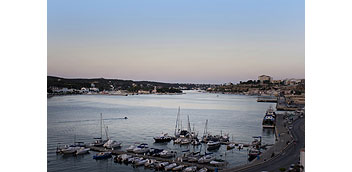
El vertido al mar de los fangos del puerto de Maó cuenta con las autorizaciones necesarias en este tipo de proyectos
01/03/2013El vertido controlado al mar del material dragado del puerto de Maó cuenta con todos los informes y autorizaciones necesarios para este tipo de proyectos que se realizan en España y además es el procedimiento recomendado por las administraciones competentes, puesto que su extracción, tratamiento y vertido en tierra podrían provocar impactos ambientales de mayor magnitud. Destaca sobre todos la salinización de los acuíferos de la isla de Menorca a consecuencia de la filtración del agua del mar que resultaría del depósito en tierra de miles de metros cúbicos de fangos con altas concentraciones de sal. Así lo constata el Organismo Público Puertos del Estado (OPPE) que apunta además otros inconvenientes por los que fue descartada la gestión en tierra de los materiales a dragar.Otro problema sería el consumo energético y el impacto ambiental que provocarían por las carreteras de la Isla el transporte terrestre mediante camiones de 200.000 metros cúbicos de material pastoso o semilíquido, así como todos los asociados por la desubicación de especies vivas de un medio marino a otro terrestre. Desde un punto de vista administrativo y de gestión estaría la dificultad del acopio temporal, transporte, tratamiento y almacenamiento de materiales fangosos, lo que provocaría una importante demora en el tiempo y un encarecimiento de la obra que harían inviable el dragado, con las consiguientes y graves implicaciones que ocasionaría para el tráfico marítimo del puerto, en especial para el de cruceros y buques de mayores dimensiones.El OPPE dio a conocer el pasado mes de enero en Maó, durante la II Jornada Técnica de puertas abiertas sobre el dragado del puerto organizado por la Autoridad Portuaria de Baleares (APB), que durante 2011 los puertos de interés general del Estado vertieron directamente al mar o bien reutilizaron en obras portuarias o marítimas la totalidad de los más de cinco millones de metros cúbicos de material dragado. La única excepción que apuntó el OPPE fue la del puerto de Sevilla, que vertió parte del material dragado en depositos en tierra, puesto que se trata de un puerto fluvial de agua no salada. A esta jornada fue invitada a asistir expresamente la organización internacional Oceana, invitación que no fue atendida.Recomendaciones del CEDEXLa APB cumple de forma estricta las recomendaciones del CEDEX, organismo de referencia en España sobre el tratamiento del material procedente de dragados. Estas recomendaciones solo contemplan el vertido de forma controlada al mar, y no en tierra, del material catalogado como categoría II. Es decir, aquel material que contiene concentraciones moderadas de contaminantes. El material a dragar del puerto de Maó ha sido catalogado como de categoría II.
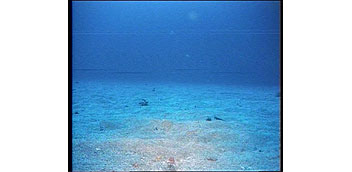
The material dredged from the Port of Maó will be disposed of at the authorised point on a seabed of sand
20/02/2013The Port Authority of the Balearic Islands (APB) will ensure that the material dredged from the Port of Maó is disposed of at the authorised discharge point in an area where the seabed is made up of coarse sand and there are no important marine species. In January, the APB commissioned a report on the most recent inspection of the seabed at the authorised discharge point as part of the first phase of the Environmental Watch Plan in the Port of Maó dredging project. The aim of this report was to obtain updated detailed information about the seabed’s composition via the collection of samples and the recording of a video. The report concluded that the dredged material should be disposed of in the northeast section of the prospected area which is made up of coarse sand and has no protected species and suggested that “the vessel should discharge the dredged material progressively as it moves away from the coast towards deeper waters” so as not to dispose of it in one particular point. This information was made public at the 2nd Technical Open Day on the dredging of the Port of Maó, organised by the APB in the Minorcan capital in January. The APB has published the video on its web site www.portsdebalears.com, its Twitter account @PortsdeBalears and on its Facebook page (Ports de Balears).
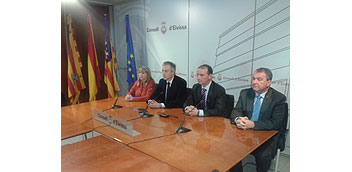
The APB to concentrate traffic to and from Formentera at the Port of Ibiza’s commercial quays
18/02/2013The APB Chairman, José Mª Urrutia, today announced the decision to concentrate all maritime traffic to and from Formentera at the Port of Ibiza´s commercial quays. This decision was made public after a meeting this afternoon with the President of the Ibiza Island Council, Vicent Serra the President of the Formentera Island Council, Jaume Ferrer and the Mayor of Ibiza, Marienna Sánchez-Jáuregui, to discuss the location of maritime traffic between the Pityusic Islands in the renovation of the Port of Ibiza. The APB Chairman pointed out that the final choice is the result of the Port Authority’s commitment to abide by the decision made by the Ibiza authorities. This area will house a passenger terminal which will be situated as close to the city as possible, and will also have enough space for car parks, public transport and pre-embarkation areas. Urrutia stated that he hopes that these facilities will be ready “in 18 months or 2 years”, and that he is committed to keeping “dialogue open with the Ibiza and Formentera authorities, and to consulting any points that may cause controversy”. For his part, the President of the Ibiza Island Council, Vicent Serra, thanked the APB “for letting us, the authorities, decide for ourselves”. The intention, according to the island President, “was to achieve the widest possible consensus”. Along these lines, the President of the Formentera Island Council, Jaume Ferrer, stressed that the best solution for Formentera was for the vessels to stay where they are, but seeing as this was not an option, the decision was made to relocate to the commercial quays. However, Ferrer did ask “to have all the necessary explanations from the APB about what the services will be like and how the area for traffic to and from the island will be set out”. The Mayor of Ibiza, Marienna Sánchez-Jáuregui, thanked the efforts made by the Ibiza and Formentera authorities and by the APB to reach the widest possible consensus.
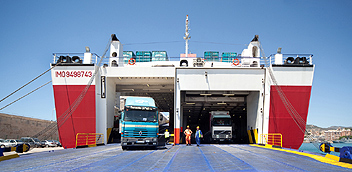
The APB ends 2012 with a turnover of €59.5 million and a net profit of €14.8 million
08/02/2013Yesterday afternoon in Palma de Majorca, the Board of Directors of the Port Authority of the Balearic Islands (APB) gave the go ahead to the provisional closure of the 2012 financial year. Turnover for the year reached €59.5 million whilst profit stood at €14.8 million. The turnover figure meant a drop of 0.69% over the previous year, and was 0.5% below the forecast. Provisional profit was 5.3% lower than 2011 yet was far superior to the forecast of €8.2 million. The APB complied with the limits imposed by Spanish Government’s Austerity Plan both in terms of staff costs and current expenditure. The APB’s receivables went down compared to 2011 as a result of two factors: a €5 million drop during 2012 in the amount of trade receivables for sales and services which reduced liabilities to €26.9 million and a €10 million increase in the provisions for insolvencies over the last two years. The APB currently has 64 trade debtors who owe amounts in excess of €10,000 and 1,500 debtors who owe smaller amounts. STP debt deferral The APB’s Board of Directors also approved a debt repayment plan requested by the firm Servicios Técnicos Portuarios, SL (STP) for €7.6 million. This amount is to be paid back over a period of three and a half years based on an amortisation table and a series of conditions that include the corresponding late payment interest and payment guarantees.
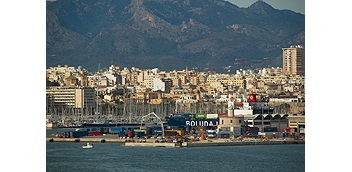
General cargo rises by five percent at the Balearic Islands’ ports
01/02/2013In 2012, general cargo handled at the Port Authority of the Balearic Islands (APB) increased by 5% to 8.4 million tonnes compared to 8 million tonnes in 2011. Traffic at the Port of Palma went up by 11% to 5.9 million tonnes, compared to 5.3 million in the previous year. Total goods traffic in the five public interest ports in the Balearic Islands rose by 3%. 11.5 million tonnes were handled in 2012 compared to 11.2 million tonnes in 2011. The Port of Palma was the only public interest port in the Balearic Islands whose volumes rose in this area whilst figures were down at the rest of the archipelago´s ports which recorded decreases of less than 10%. In 2012, traffic at the Port of Mahon fell by 9% to 729,472 tonnes, goods handled at the Port of Ibiza dropped by 8% to 1.8 million tonnes, figures at Alcudia went down by 3% to 1.5 million tonnes and La Savina fell by 1% to 268,311 tonnes. Other traffic The Port of Palma was also the only port to grow in terms of general cargo traffic in 2012 although figures for the Port of La Savina remained unchanged at 252,873 tonnes. These decreases were also less than 10%: 9% at Ibiza (1.4 million tonnes) and Mahon (537,724 tonnes), and 7% at the Port of Alcudia (250,045 tonnes). The Port of Palma registered an increase in solid bulk traffic, basically thanks to cement exports. This represented a rise of 28% to 243,717 tonnes, whilst figures were down at the other ports: Mahon -57%, Ibiza -29%, La Savina -9% and Alcudia -2%. Finally, liquid bulk (basically fuel) traffic rose in 2012 at the ports of Ibiza and Mahon, by 3% and 1% respectively, and fell at the Majorcan ports of Alcudia (-11%) and Palma (-5%). For further statistical information, visit www.portsdebalears.com.
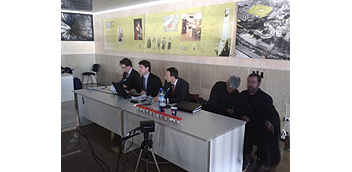
The APB discloses the IEO report on the dredging of the Port of Maó following its release
31/01/2013The Port Authority of the Balearic Islands (APB) has informed the competent authorities about the report compiled by the Spanish Institute of Oceanography (IEO) on the dredging project for the Port of Maó, as its contents became available. This took place on 16th January when the APB received a copy of the report from the Directorate General of Fishery Resources and Aquaculture, after expressly requesting it when it became aware of its existence. In the light of the IEO report, the APB has carried out further studies which have been sent to this public research body in order to resolve the issues which have arisen. More specifically, a new marine currents study has been carried out to ensure the protected environment of the Isla del Aire is not affected. In addition, more information on the dredging discharge point has been provided which has led to the introduction of additional precautions in the Environmental Watch Plan, including a new survey of the benthic floor in the dredging’s preoperational phase. The conclusions of these new studies were made public during the month of January at the 2nd Technical Open Day on the dredging of the Port of Maó which concluded that the material to be dredged is category II, which means that it can be discharged in a controlled manner into the sea. It should be mentioned that the environmental management of this dredging has been planned in line with CEDEX Recommendations for the Management of Dredged Material in Spanish Ports which were adopted to coordinate the environmental management of dredging operations in Spain according to the guidelines developed in international marine environment conventions.
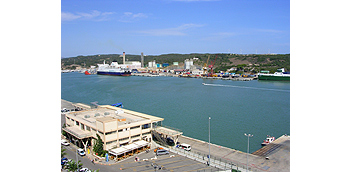
La APB organiza la II Jornada Técnica de puertas abiertas sobre el “Dragado de la zona próxima a la estación naval y el Cós Nou del puerto de Maó”
16/01/2013Con el objeto de continuar manteniendo informada la sociedad menorquina en relación al proyecto “Dragado de la zona próxima a la Estación Naval y el Cós Nou del puerto de Maó”, la Autoridad Portuaria de Baleares celebra el martes, 22 de enero de 2013, en la Estación Marítima del puerto de Maó (Moll de Ponent s/n) a las 12:30h, una nueva jornada técnica de puertas abiertas para explicar los detalles de la actuación.La jornada contará con la participación de: -Jorge Martín. Explotación, Servicios y Territorio de la Autoridad Portuaria de Baleares Experiencia de la APB en los dragados de los puertos de interés general de las Islas Baleares-Francisco Mir. Centre Balear de Biologia Aplicada (CBBA)Aclaraciones sobre el estudio de caracterización del sedimento del puerto de Maó-Técnico representante del Departamento de Calidad Ambiental del Organismo Público Puertos del EstadoExperiencia en la gestión del material procedente de los dragados en los puertos españoles- Benjamí Reviriego. Centre Balear de Biologia Aplicada (CBBA)Características del sedimento a dragar en el puerto de Maó y afección al medio ambiente-Antonio Ginard. Proyectos y Obras de la Autoridad Portuaria de BalearesTramitación para la ejecución de las obras y primeras actuaciones del Plan de Vigilancia Ambiental del dragado del puerto de Maó
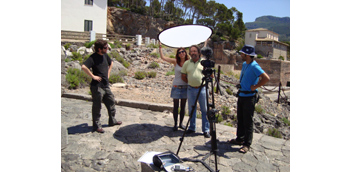
La Autoridad Portuaria de Baleares está recogiendo los testimonios directos de los últimos fareros de las Islas
09/01/2013La Autoridad Portuaria de Baleares (APB) está recogiendo los testimonios de los últimos fareros de las Islas con la realización de una serie de entrevistas en vídeo a personas que tienen o han tenido una relación directa con este tradicional oficio. Con la puesta en marcha, hace unos años, del portal web www.farsdebalears.com, la APB expone al público, a través de la red, varias entrevistas a ex fareros o familiares que cuentan en primera persona sus vivencias directas con los faros.En la última entrega de estas entrevistas, el director del Jardín Botánico de Sóller, Josep Lluís Gradaille, explica como su infancia y adolescencia en el faro del sa Creu del Puerto de Sóller -donde su padre ejerció de farero-, marcó su madurez y su relación directa con la naturaleza y su forma de entenderla. En su blog personal, el presidente de la APB, José Mª Urrutia, afirma que esta iniciativa de recoger los testimonios de los último fareros de las Baleares persigue “el firme propósito de preservar para generaciones venideras la memoria viva de sus protagonistas y sus experiencias” a consecuencia de que en la Ley de Puertos y de la Marina Mercante de 1992 se declaró a extinguir el Cuerpo de Técnicos Mecánicos de Señales Marítimas.Entre otros testimonios que han sido recogidos por la APB figura el de Pere Bonet, el último farero de Portopí, el tercer faro en funcionamiento más antiguo del mundo, la historia de Santi Ribas, que heredó el oficio de su padre Jaume, farero del Botafoc, en el puerto de Eivissa o las calamidades por las que pasaban los fareros aislados en la Isla del Aire, en Menorca.Otros testimonios que están en producción y serán publicados en breve en www.farsdebalears.com son el regreso al faro de n’Ensiola, en la isla de Cabrera, del ibicenco Mariano Juan, veinte años después de su jubilación y las anécdotas de Bernat Reus en sa Dragonera, la isla de los tres faros.






